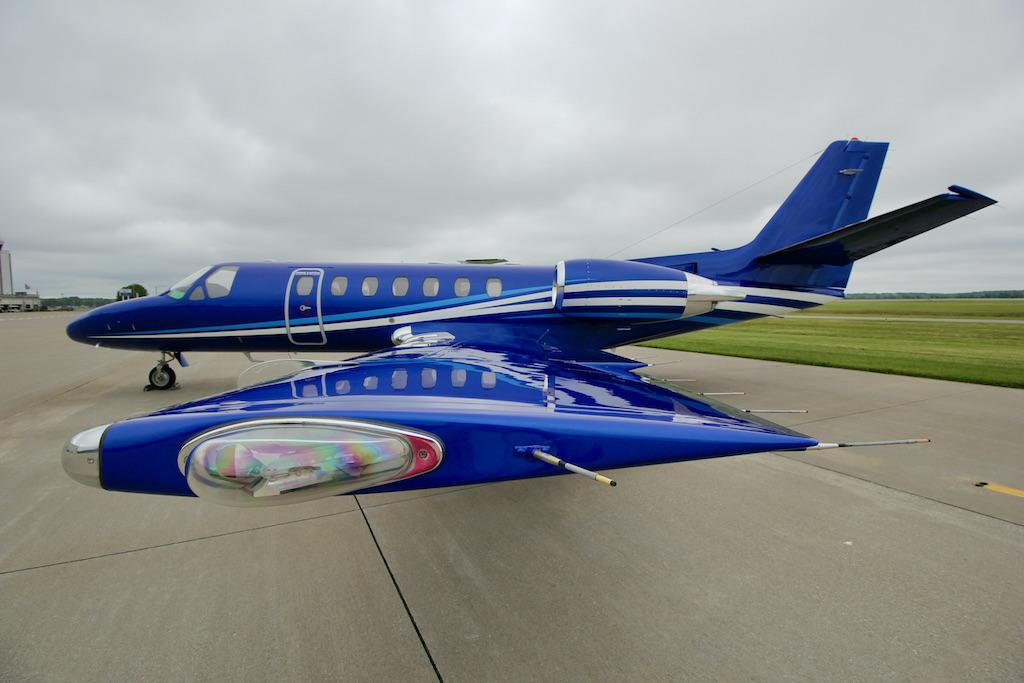
The business aircraft repainting market is experiencing shifting winds. With depleted inventories of used jets—a major driver of exterior refreshment—owners are keeping their current aircraft longer and lining up for new paint jobs.
According to Sam Millikin, PPG Industries global director for coatings and sealants, aerospace products, current market demand is above 2019 levels, with continued growth foreseen throughout 2022, given year-over-year increases in business aircraft flying.
“Along with growing demand, we are seeing a trend toward more colorful aircraft, incorporating darker colors,” says Millikin. “As customers move away from basic white and stripes, we will see more colorful aircraft with vibrant effect colors, such as metallic and mica. Additionally, the incorporation of matte finishes will provide new styling options.”
Pittsburgh-based PPG, a paint supplier, recently announced a partnership with Aerobrand, a UK-based brand and design consultancy, that will enable clients to work closely with designers to create custom paint colors and liveries, says Millikin.
Custom Paint Jobs

Aircraft painting vendors also anticipate a robust market. The business aircraft market is being driven by first-time buyers of new or used aircraft, current owners who want an upgraded paint scheme and fleet customers who want a standard livery on all their aircraft, says Meghan Welch, director for paint and interior sales with Elliott Aviation in Moline, Illinois. “Demand from all of those groups is about even,” Welch says. “In fact, we are seeing more customized paint work and greater investment in the exterior paint design because owners want something that is truly their own.”
Tracy Leopold, Textron Aviation vice president for North American service centers, says the company has had a consistent backlog for complete strip-and-paint work since 2020, with current paint slots sold out several months in advance. “We continue to experience a steady pipeline of work, at our Indianapolis and Wichita Service Centers which do our aircraft painting,” Leopold reports. “With a lower inventory of both new and used aircraft, more owners are choosing to invest in their current aircraft.”
Even in an inflationary period, Lincoln, Nebraska-based MRO Duncan Aviation is significantly busier this year at its paint facilities, says Adam Bruce completions and paint sales representative.
“Our painting business is robust,” Bruce reports. “Customers are booking farther ahead—on average about 90 days in advance—to reserve paint slots. Not only are they having to schedule farther out, but they have to consider alternative dates. Now we are discussing more alternative dates for slot scheduling, rather than requested dates.”
Among the factors driving the market Bruce cites are increasing flight hours and more maintenance events that generate opportunities to combine the work with painting. “This is particularly the case with major inspections,” he notes.
Bruce adds that Duncan Aviation is heavily focused on metallic and pearl finishes and customized tints. “We do very little ‘plain white’ anymore and requests for customization unique to the owner are increasing,” he says. “But, the paint products required for this specialized work can take 30-45 days longer for delivery to the paint facility than in years past.”
Rising Material Costs
Despite ongoing demand for their services, aircraft painting vendors as with other businesses are being affected by rising material costs and supply chain bottlenecks. Not all painting companies have experienced an uptick in business.
Andrew Skigen, a partner of Atlantic Jet Refinishing, says the Fort Lauderdale-based company is seeing no real change in demand for its services. “With used aircraft sales having slowed, we anticipate a dip in that portion of our paint business,” he reports.
Skigen also points out that while he has not had difficulty obtaining products from paint manufacturers, prices have risen for everything the company purchases. “We have had to pass along the increased cost of doing business to our customers,” he says. “Fortunately, we have been able to control some costs, so our fees have not risen significantly.”
Increasing costs of supplies could slow the trend “toward more extravagant designs,” cautions Walter Krolikowski, Yingling Aviation paint manager. “Primer is particularly constrained because the chemical components are in short supply,” he says. The time “from ordering to delivery, which once took a few weeks, can now be as long as six months.”





